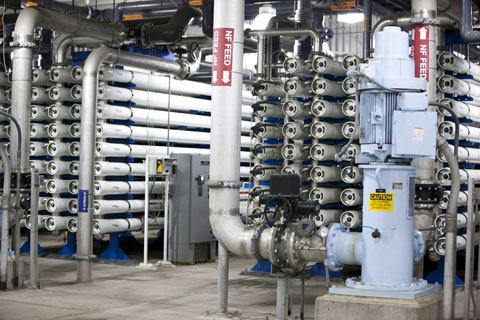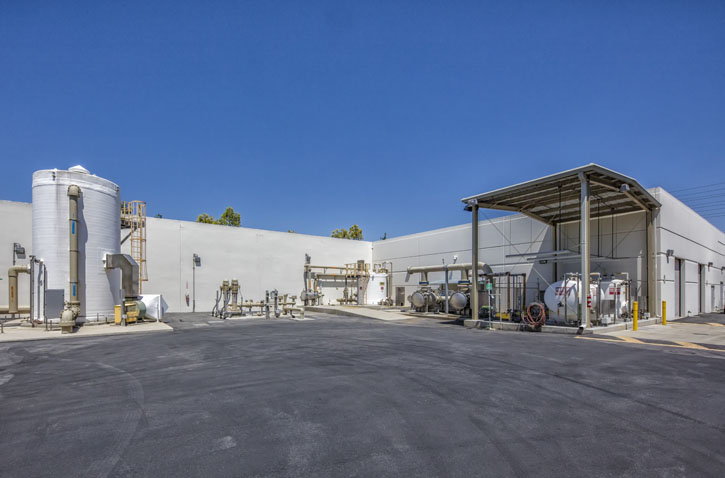IRWD Facilities
IRWD is Orange County's largest retail water district, providing water and sewer service to more than 100,000 homes and businesses throughout Irvine and portions of Lake Forest, Tustin, Newport Beach, Costa Mesa, Orange, and unincorporated Orange County. Below are some key facilities in our delivery and treatment systems.
Baker Water Treatment Plant
The Baker Water Treatment Plant provides 28.1 million gallons of drinking water per day. A joint regional project by South Orange County water districts, it opened in 2017 at the site of the former Baker Filtration Plant in Lake Forest.
Deep Aquifer Treatment System
The Deep Aquifer Treatment System purifies drinking water from deep within the Orange County Groundwater Basin. The process removes impurities left from ancient vegetation in the bedrock, and produces eight million gallons of drinking water each day.
Irvine Desalter Project
The Irvine Desalter Project consists of five wells near the I-5 Freeway in Irvine. Salty water is pumped from these wells and sent to the IDP treatment facility. The treatment process removes salts from local groundwater to add to local drinking water supplies. IDP provides 5,1000 acre-feet (1.6 billion gallons) of purified drinking water per year, enough for 50,000 people.
El Toro Groundwater Remediation Project
The El Toro Groundwater Remediation Project has been in full operation since 2007, removing trichloroethylene (TCE) from isolated portions of the groundwater basin beneath the former El Toro Marine Corps Air Station and central Irvine. After treatment to remove TCE, the water is used only for nondrinking purposes. Each year the project provides 1.3 billion gallons of clean water, enough to irrigate 1,300 acres of landscaping. Clean-up of the TCE plume is expected to take about 40 years.
Michelson Water Recycling Plant
The Michelson Water Recycling Plant converts an average of 28 million gallons of sewage each day into recycled water. The water is used for landscape irrigation, industrial uses and toilet flushing. The plant was built in 1961 and is IRWD's primary source of recycled water. A major plant expansion was completed in 2014.
Biosolids and Energy Recovery Facility
IRWD's Biosolids and Energy Recovery Facility is a state-of-the-art system on the Michelson Water Recycling Plant site that adds a second layer to the sewage treatment process. It converts the solids left over from the water recycling process into a valuable resource that can be used as fertilizer or fuel. The facility also harnesses the biogas produced from the process and uses it to generate electricity to power the facility.
Los Alisos Water Recycling Plant
The Los Alisos Water Recycling Plant converts an average of 7 million gallons of sewage each day into recycled water. The water is used for landscape irrigation and other nondrinking uses. The plant was built in 1964.
Recycled water reservoirs
IRWD owns and operates four seasonal-storage reservoirs for recycled water — Rattlesnake Reservoir, San Joaquin Reservoir, Sand Canyon Reservoir, and Syphon Reservoir. The reservoirs are pumped full of recycled water from IRWD’s recycling plants during the cooler, wetter winter months when irrigation demands are low. The water is stored in the reservoirs, and then withdrawn in the summer when demand is high. The reservoirs feature dams, which are inspected regularly and are certified safe.
Irvine Lake
Irvine Lake (formerly Santiago Reservoir) was built in 1931 to supply water for agriculture. It was opened to fishing ten years later. The 700-acre lake holds more than 9 billion gallons of water that is contained by the Santiago Creek Dam.
Wells 21 and 22 Pipelines, Wells and Water Treatment Plant
Wells 21 and 22 Project recovers and treats local impaired groundwater for use in the potable water system. This new source of drinking water helps to satisfy increasing demand for water and serves as a sustainable infrastructure with long-term benefits. The Wells 21 and 22 project produces approximately 6,300 acre-feet per year of potable water for the IRWD service area.
Marsh Campus
IRWD's San Joaquin Marsh Campus includes the Duck Club, Audubon House, Learning Center, Visitors Center, Sea and Sage House, and Caretaker's House.





